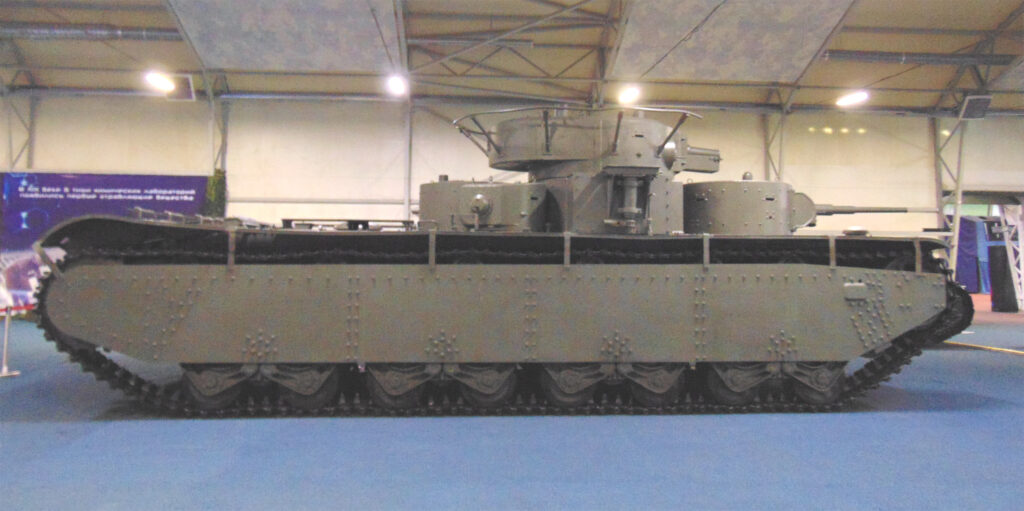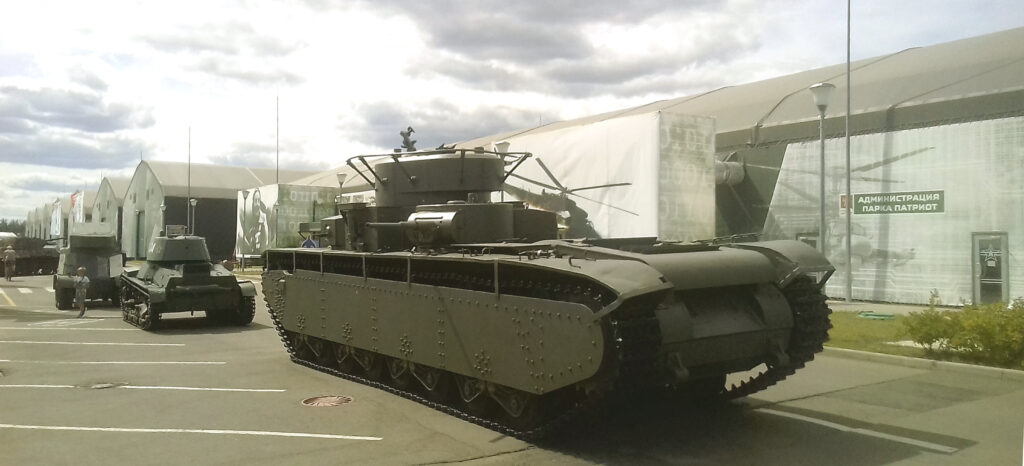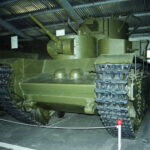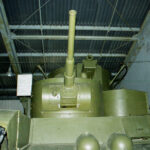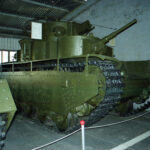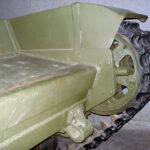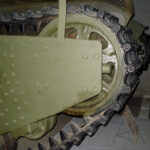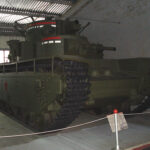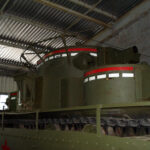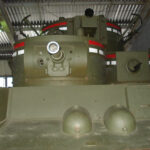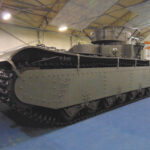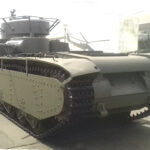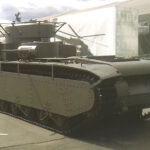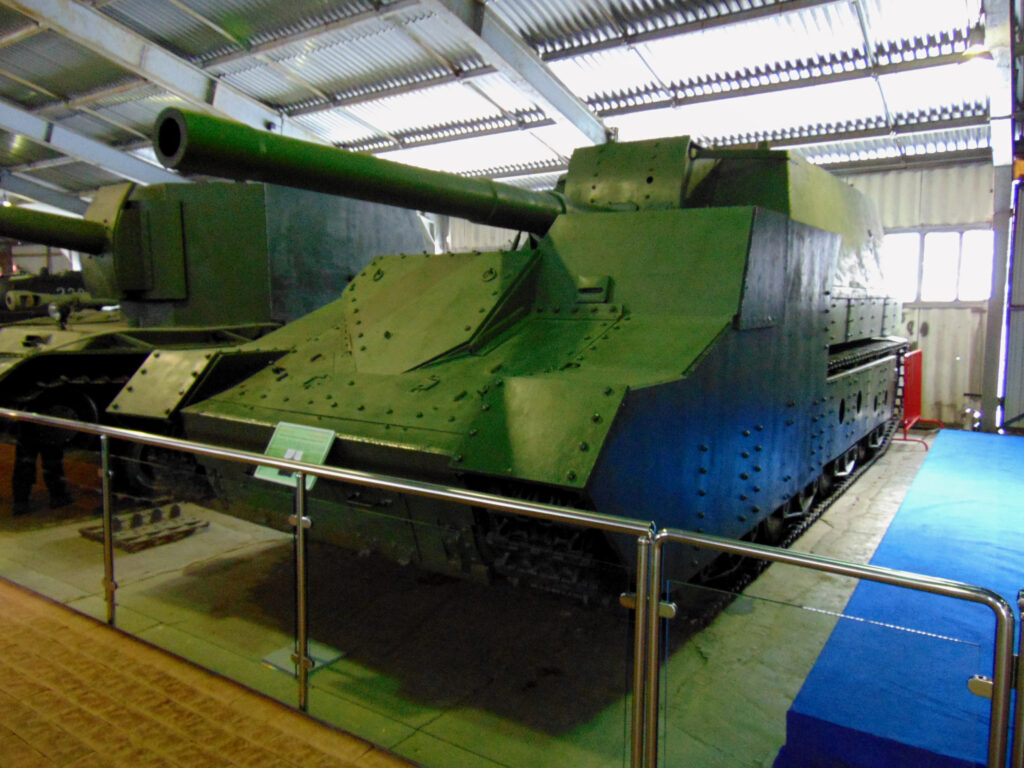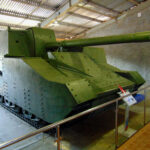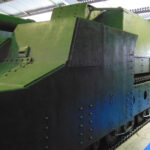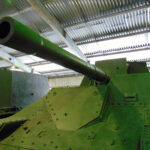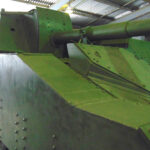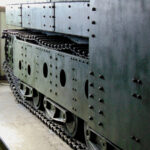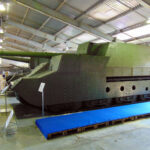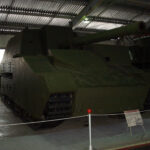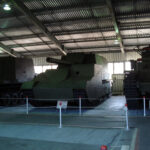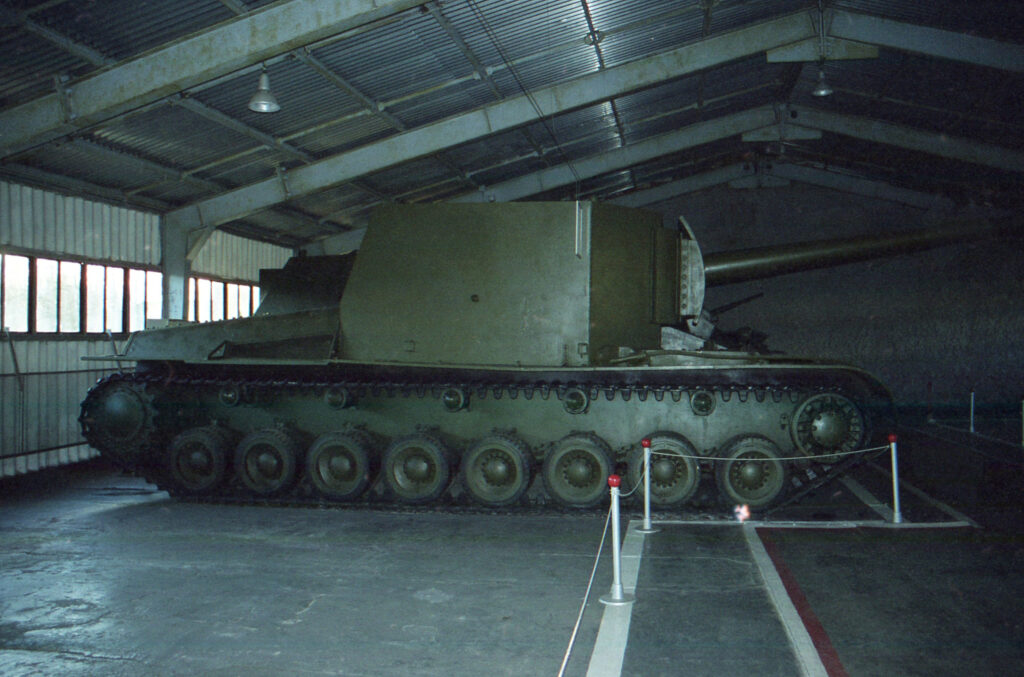After the Second World War, for a long time the Soviet T-35 tank was kept in Hangar N1 in the Kubinka Tank Museum. According to the official Museum catalog from 1994, the T-35 is also listed in Hangar N1 in the list of Soviet heavy tanks and self-propelled guns. After the reorganization and creation of the Patriot Park in 2015, the T-35 tank was moved to the Museum site N 1, inside the halls, but sometimes on holidays it is shown on the outdoor exhibition in front of the entrance.
Soviet heavy tank T-35, 1933, serial, (official catalog).
Military service:
- pre WW2, Red square military parades
- Soviet- Finland war (“Winter war”)
- World War Two (early period)
Participated in the Great Patriotic War (initial period)
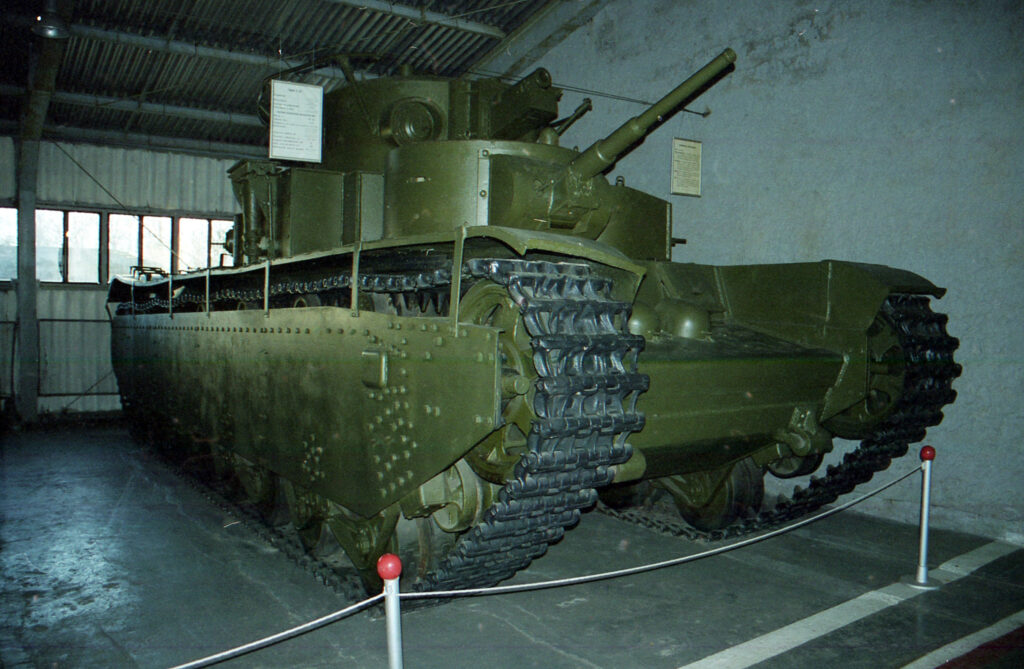
Permanent display location in Hangar N 1 of the Kubinka Tank Museum from 1972 to 2015 (Archive photo)
- T-35 in the Hangar of Soviet heavy tanks and self-propelled guns (2003)
- Front tank turrets (2003)
- 5 turret tank T-35 is good for parades on Red Square, but not for battlefields
- Left idler wheel close up (2006)
- Right idler wheel and chassis bulletproof protection
- Tank turrets with tactical insignia (2006)
- T-35 tank with tactical markings, as seen at a military parade on Red Square in Moscow
- Radio antenna around a tank turret (2006)
- Another view of the radio antenna and tank turrets
- Rear view of the chassis and tank turrets
- From 1972 to 2015 the rear view of the T-35 tank was not available to visitors
- Another T-35 tank rear view (2019 archive)
Soviet T-35 tank
The tank was produced serially from 1933 to 1939. Served in the Red Army
Tactical and technical characteristics of the T-35 tank:
Weight – 50 tons. Dimensions (length x width x height) – 9720 x 3200 x 3430
Crew – 11 people
Armament:
gun – 1 pc. , caliber – 76.2 mm., ammunition – 96 shots
gun – 2 pcs., caliber – 45 mm., ammunition – 220 shots
machine gun – 5 pcs., caliber – 7.62 mm., ammunition – 10000 pcs.
Armor Protection:
the forehead of the body is 50 mm., the tower – 20 mm., the board – 20 mm., the bulwark – 10 mm.
Engine power – 500 h/p
The maximum speed is 30 km / h, the power reserve is 100 .. 200 km.
The depth of the water barriers to be surfaced is 1.7 m.
Features of the T-35 tank design:
The base of the T-35 tank is the original one. The layout is classical. The control compartment is located in the front part of the hull, the combat compartment is in the middle, the engine and the transmission in the stern.
Armament of the T-35 tank is located two-tier in the five turrets of the tank. A short barrel, the KT-28 tank cannon of caliber 76.2 mm. is installed in a central turret with a circular rotation. Two 45-mm. The tank guns of the 1932 model were installed in diagonally located turrets of the lower tier and could simultaneously fire forward-to-right and back-to-left. Two tank machine gun of caliber 7.62 mm. paired with 45 mm. guns, three more are located in the ball bearings of the central and machine-gun turrets.
Chassis. The carburetor V-shaped 12-cylinder liquid-cooled engine M-17T is located longitudinally with the toe of the crankshaft to the stern and is connected to the 4-speed manual gearbox, airborne friction clutch and on-board gears via the multi-disk main friction clutch of dry friction.
The pendant is grouped into carts by two rollers. Rollers sprung with spiral springs. Between the guide wheel and the first support roller, a tension roller
Fragments of history.
Based on the tanks of the company “Сarden-Lloyd-Vickers” bought in Great Britain in the early 30s, they developed their own heavy tanks. One of these Soviet T-35 tanks was developed in 1933. Before the beginning of the Great Patriotic War, 61 pieces were manufactured that were in the reserves of the Supreme Command and demonstrated the military might of the Soviet state in parades on Red Square. The same tank is depicted on the combat reward, medals.
In 1941, all these tanks were used in battles for Western Ukraine and in the battle for Moscow, and all were lost. Only one sample in Kubinka has survived.
This heavy soviet T-35 tank you can see at the Red Square military parades pre-WW2.
This tank also displayed on the very popular medal “For Bravery” (Medal of Honor).
The tank was recently renovated and is in working order. It took part in the WW2 historical reenactment of the Battle for Moscow (?).
At summer 2019 the temporary locations: 1) outdoor expo near VKS 2) Hall N3 of Patriot park. Ask you travel guide about current position.
Modifications and armored vehicles on the T-35 chassis.
Soviet heavy Assault Gun SU-14
Current location: ex. Kubinka tank Museum, pavilion N1 (Soviet heavy tanks and self-propelled units – USSR armored vehicles).
- Monsters of the Soviet-Finnish Winter War (Hall 1)
- Front armor and driver’s seat
- 152 mm heavy naval gun from the First World War era
- Gun mask and sight
- Rear chassis, double rollers
- View of the SU-14 chassis and deckhouse on the left (2019)
- View of the SU-14 self-propelled gun when the hangar was dark and cold (2006)
- View of the SU-14 next to the T-35 tank and SU-100U AG (2006)
Soviet heavy self-propelled unit SU-14-2, 1939, the only sample (as a official catalog).
There is a legend originating from museum veterans that this self-propelled gun was used to defend the Kubinka railway station a few kilometers from the museum. During the Battle of Moscow in 1941, the front passed just 6 kilometers from the museum and the training ground was temporarily evacuated. It is not yet possible to verify this legend, since the archive of the museum (test site) was destroyed in 1992 during declassification. According to another version, this self-propelled unit took part during the Soviet-Finnish Winter War and showed many shortcomings of the chassis. The events of October 1941, when Moscow was planned to be surrendered to the Germans, are the most unknown and documents are almost completely absent. At this time there was great chaos and there were few reports, very few documents survived. Our team found a unique real map of the commander of the northwestern section of the defense of Moscow with all positions and donated it to the T-34 tank Museum. We also present this map with all positions on our guide in the Battle of Moscow section. The map was supposed to be transferred to Patriot Park, but the management showed no interest (laziness is a national trait in Russia) and the exhibit was transferred to another museum.
SU-14 Soviet heavy Self-propelled Gun
The self-propelled installation was developed in 1939 to break through the fortified “Mannerheim Line”. Released in a single copy. I was not in service with me. It was used in battles during the Soviet-Finnish war and in the battle for Moscow. From the Kubinka area a self-propelled unit fired on the advancing enemy.
Tactical and technical characteristics of SU-14-2:
Weight – 65 tons. Crew – 7 people.
Overall dimensions (length x width x height), mm. – 10,000 x 3370 x 3560
Armament:
gun – 1 pc., caliber – 152 mm., ammunition – 16 shots
machine guns – 4 pieces, caliber – 7.62 mm., ammunition – 2655 shots
Armor protection SU-14-2: forehead hull and felling – 50 mm
Engine power – 500 l / s
The maximum speed is 25 km / h
Cruising range on the highway – 150 km.
The depth of the water barriers to be surfaced is 1 meter
Features of the construction of SU-14-2
SU-14-2 base – special, the units of T-28 and T-35 tanks are used.
General layout – the combat compartment is located in the middle and rear parts of the body, the engine-transmission and control compartment – in the front.
Armament – the gun has a pedestal unit with swinging armor; machine guns are placed in front, along the sides and in the stern of the felling.
Protection – the body is welded and riveted from rolled parts.
Chassis. Engine 12-cylinder, V-shaped, four-stroke, carburetor, liquid cooling; transmission mechanical; suspended suspension, spring.
Based on the experience of combat operations on the battlefields of the Soviet-Finnish “winter” war, it was concluded that the T-35 tank chassis and the SU-14 self-propelled gun are not suitable for combat operations in forested and swampy areas. A cart with two rollers is suitable for the Western Front, but not for the Eastern Front. The design bureau began to develop a new type of chassis in the style of the KV tank. Thus, the experimental self-propelled unit SU-100 U appeared, created to break through the forts of the Mannerheim Line. When the SU-100 U was ready, the Soviet-Finnish war had already ended. According to the stories of the guides of the Kubinka Tank Museum, in 1941 the self-propelled gun also took part in the battles for Kubinka area, but this fact is refuted by some historians.
Soviet SU-100 U heavy experimental assault gun
Location: Kubinka Tank Museum, pavilion N1 (Soviet heavy tanks and self-propelled units – USSR vehicles and equipment).
Soviet heavy self-propelled gun SU-100U, 1939, the only sample (official catalog).
It was developed in 1939 to storm the reinforcement of the Mannerheim Line. Released in a single copy. I was not in service with me. Used in the battles of the Soviet-Finnish war
Assault Gun SU-100U tactical and technical characteristics
The weight of SU-100U is 64 tons. Crew – 6 people
Overall dimensions (length x width x height), mm. – 10900 x 3400 x 3290
Weaponse:
gun – 1 pc. , Caliber – 130 mm., Ammunition – 30 rds.
machine gun – 3 pieces, caliber – 7.62 mm., ammunition – 1800 rifles.
Armor protection SU-100U: forehead and hull – 60 mm.
Engine power – 890 horsepower.
The maximum speed is 32 km / h. Cruising range on the highway – 200 km.
The depth of the water barriers to be surfaced is 1 meter
Features of the design of SU-100U
Base – the original, on the chassis of an experienced heavy tank T-100.
General layout – the combat compartment is located in the middle of the car body, the engine-transmission – in the rear and the control compartment – in the front.
Armament SU-100 U – the gun is installed on trunnions and embrasure of the frontal sheet of the felling, covered with mobile armor; machine guns are placed along the sides and in the stern of the felling. Protection – the body is welded and riveted from rolled parts.
Chassis – engine 10-cylinder, V-shaped, four-stroke, liquid cooling; transmission mechanical; suspension – individual, leaf springs without shock absorbers.

